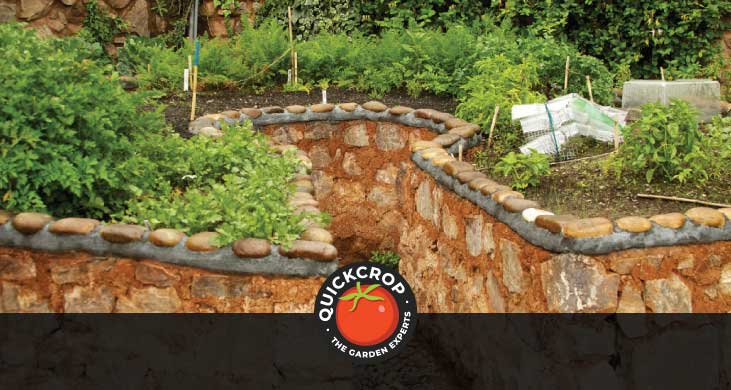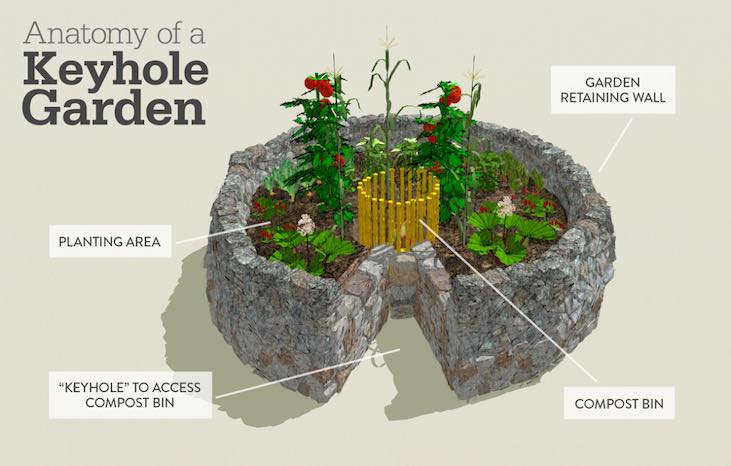Keyhole Gardening

There are no bounds when it comes to creativity when it comes to gardening, and the keyhole garden is a pretty neat example. This raised bed method of growing vegetables in a compact space is both adaptable and sustainable, while it also cuts down on the amount of work or back-strain involved. Keyhole gardening is a great example of a vegetable-growing practice that originated in very specific circumstances, before slowly but steadily seeing more widespread usage. It shares common characteristics with other methods you may have heard of, such as ‘hugelkultur’ or trench gardening.

If we’re to sum it up before going into more detail, keyhole gardening involves re-using a host of materials around the garden or home to build a raised vegetable bed. The ‘keyhole’ refers to its shape or design, which is most commonly circular, with a recessed path in the middle that leads inwards. This path allows the vegetable grower to have comfortable access to all areas of the bed. A compost basket or container is placed centrally in the bed, around which the surrounding soil slopes gently downwards (an overall slope of around 2 inches is recommended). Because of the way these vegetable beds are built up - using layers of compost, manure and other organic materials - they have proven adept at retaining moisture in challenging climates; whilst the addition of continuously composting material provides a steady delivery of nutrients to the vegetable beds.
While there have been quite similar structures used to grow vegetables at different times in history, the ‘keyhole garden’ as we know it was developed in Lesotho in South Africa, an area prone to long droughts and crop failure. Crop output proved to be very successful using this method. The practice was soon adopted by increasing numbers of families looking to provide their own homegrown food, and soon spread to other areas like Kenya, Rwanda and Ethiopia. In more recent times, it has similarly been adopted in drought-prone areas of America such as Texas. And well, who knows? With the way the world is headed we may all be becoming familiar with droughts in the future. So it’s interesting to think about the successes of keyhole gardening and what it may have to offer.
Confession here: we’ve never actually put this method into practice here at QC HQ (Quickcrop Headquarters). After all - where we’re based rainfall is rarely far away. In moderate climates where soil is easily optimised, the keyhole garden may not seem like it would be worth the initial workload. But there are plenty of acolytes of the gardening technique out there, and we do like reading about it and seeing the unique designs that people create (while raised beds tend to have a familiar design, you’re more likely to see a lot of variance with keyhole beds - no two are going to look exactly the same!). Have you set one up or attempted one yourself? Send us some pictures!
Related Article: Raised Bed Vegetable Gardening
The Composting Basket
The compost basket or container should be placed in the centre of the bed - around a metre higher than the walls enclosing the bed. In here you can put kitchen scraps, yard waste or other organic matter. The compost basket can be made from perforated or mesh materials - think chicken wire, rabbit fencing, twine etc. It should be porous or have plenty of holes to provide access for worms, as well as allowing water to flow outwards. Placing small rocks at the base of the container will assist with drainage and aeration, ensuring that the pile doesn’t become soggy or waterlogged.
As the material breaks down, it will provide a continuous source of nutrients for surrounding vegetable roots to seek out. Worms can carry this nutrient-rich mulch outwards, meaning that it won’t be too concentrated in one central area (The slope of the soil will also aid this process). In a sense, you’re cutting out the middleman of a compost pile and adding organic matter straight to your vegetable bed, while also giving it time to break down somewhat before it’s absorbed. It’s best not to add cooked meat scraps or bread. Greens and browns should be well-balanced to avoid a smelly compost pile - you want your vegetable garden smelling nice after all. Much like with the soil, you should try to layer the compost basket as much as you can with the materials that you have. A layer of soil placed over the aforementioned drainage layer of rocks can be beneficial. Meanwhile, a layer of brown materials placed over the top of the pile can discourage interference from pests and animals.
Because these nutrients are continually replenishing your vegetable garden, you won’t need to add fertilisers as much as you would with a traditional vegetable bed. It’s also common practice to water the keyhole garden via this central basket: this will help flush nutrients out and into the surrounding soil. A further benefit is that it waters the vegetable garden steadily from below the roots (rather than watering the topsoil and potentially losing moisture to evaporation).
Keyhole Design
The notch or keyhole path makes the raised bed very suitable for accessible gardening, allowing you to easily reach any area of the bed. Indeed, one of the reasons for its original design was that a lot of people in Lesotho suffered poor health (Lesotho had, and still has, very high rates of HIV infection) and found it difficult to spend periods of time bending or kneeling to tend to crops. While many keyhole beds are circular in design, this is by no means the only way it has to be arranged. They can be oval, rectangular…the nature of how the bed is constructed leaves a lot of room for creativity and your own personal touch. Similarly, the bed can be as high or low as you want it to be.
The notch (or path) should be spacious enough to allow you to work comfortably. The bed itself should ideally be less than 6 feet in diameter, as you want nutrients from the compost pile to reach all the roots.
View Product: No-Waste Organic Gardening by Shawna Coronado
Layered Soil
The soil in a keyhole bed is carefully layered to optimise soil health. Think of it as being a little bit like a lasagne. The bottom layer should consist of material like twigs, gravel, cardboard or wood ash. This will ensure healthy drainage and prevent nutrients from leaching out of the bed. Layering compostable materials such as cardboard, grass clippings and newspaper in the next layer up will promote moisture retention (aim for a mix of brown and green materials). The topsoil can then be placed over these layers. Additionally, adding a layer of dried leaves, bark or wood chip around the base of plants can act as a mulch and help to keep the moisture in the soil so they can avail of it.
Moisture and Water Retention
One of the key (ha) benefits of the keyhole garden is that it will need watering less than a conventional one. There’s no exact scientific answer as to why these beds do so well at retaining moisture, but there’s a few probable factors.
- The layers of organic material under the topsoil create a healthy soil structure that will effectively absorb and retain moisture.
- A surrounding border of materials like blocks or bricks can absorb heat and reduce evaporation.
- Irrigating via the central compost basket brings water to the roots and allows it to be absorbed more efficiently.
- It’s also common practice when growing in a keyhole raised bed to add a mulch of organic material around newly planted crops; this will further retain moisture while keeping the soil cooler in hot conditions.
To add to the water conservation benefits, use ‘grey water’ (ie water used for laundry, dishwashing etc) when irrigating the central container.
Sustainability
It’d be hard to think of a better example of sustainability in action than a keyhole bed. Pretty much every part of it involves re-using or re-purposing materials, whether it’s unused bricks, concrete blocks, straw bales or old tyres lying around. A keyhole raised bed should sustain itself for at least a few years. Meanwhile it encourages water conservation due to the efficient way you can irrigate your crops - and its ability to retain this moisture.
Crops that do really well in a keyhole garden include carrots, onions, beetroot, radish, garlic, swiss chard, spinach and various herbs. As mentioned earlier, the keyhole garden may be best suited to people who live in very hot, drought-prone areas. But that doesn’t mean you can’t try it out even if you live in a milder or more moderate climate. If nothing else, it’s a fun arts and craft experiment and keyhole gardens have a really unique character to them.
